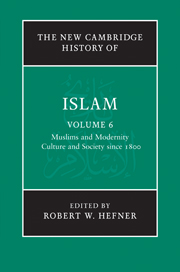Book contents
- Frontmatter
- 1 Introduction: Muslims and modernity: culture and society in an age of contest and plurality
- PART I SOCIAL TRANSFORMATIONS
- 2 New networks and new knowledge: migrations, communications and the refiguration of the Muslim community in the nineteenth and early twentieth centuries
- 3 Population, urbanisation and the dialectics of globalisation
- 4 The origins and early development of Islamic reform
- 5 Reform and modernism in the middle twentieth century
- 6 Islamic resurgence and its aftermath
- 7 The new transnationalism: globalising Islamic movements
- 8 Muslims in the West: Europe
- 9 Muslims in the West: North America
- 10 New frontiers and conversion
- PART II RELIGION AND LAW
- PART III POLITICAL AND ECONOMIC THOUGHT
- PART IV CULTURES, ARTS AND LEARNING
- Glossary
- Bibliography
- Index
- References
9 - Muslims in the West: North America
from PART I - SOCIAL TRANSFORMATIONS
Published online by Cambridge University Press: 28 March 2011
- Frontmatter
- 1 Introduction: Muslims and modernity: culture and society in an age of contest and plurality
- PART I SOCIAL TRANSFORMATIONS
- 2 New networks and new knowledge: migrations, communications and the refiguration of the Muslim community in the nineteenth and early twentieth centuries
- 3 Population, urbanisation and the dialectics of globalisation
- 4 The origins and early development of Islamic reform
- 5 Reform and modernism in the middle twentieth century
- 6 Islamic resurgence and its aftermath
- 7 The new transnationalism: globalising Islamic movements
- 8 Muslims in the West: Europe
- 9 Muslims in the West: North America
- 10 New frontiers and conversion
- PART II RELIGION AND LAW
- PART III POLITICAL AND ECONOMIC THOUGHT
- PART IV CULTURES, ARTS AND LEARNING
- Glossary
- Bibliography
- Index
- References
Summary
The North American contexts
In North America, unlike Central and South America where Islam remains an insignificant force, Muslims are overtaking Jews as the principal non-Christian minority group. Canada and the United States have certain similarities: both are predominantly Christian nations with relatively high levels of religious belief and practice and neither country has an establishment church. The twentieth century saw important changes in the religious landscape of the two countries. The mainline Christian denominations so important in the Anglo-Saxon Protestant world have been weakened, in the US by rising educational levels, intermarriage and movement to new localities, and in Canada by growing numbers of people disassociating from organised religion. A second trend is the growing importance of women in religious arenas traditionally dominated by men. Women in America arguably participate more in Christian religious activities and institutions and exercise greater moral authority in religious and civic institutions. Third, particularly in the US, special purpose religious groups have increasingly organised along conservative and liberal lines, mobilising political coalitions on issues like homosexuality and abortion. Fourth, the public dimensions of religious culture in both countries have expanded.
- Type
- Chapter
- Information
- The New Cambridge History of Islam , pp. 238 - 253Publisher: Cambridge University PressPrint publication year: 2010

